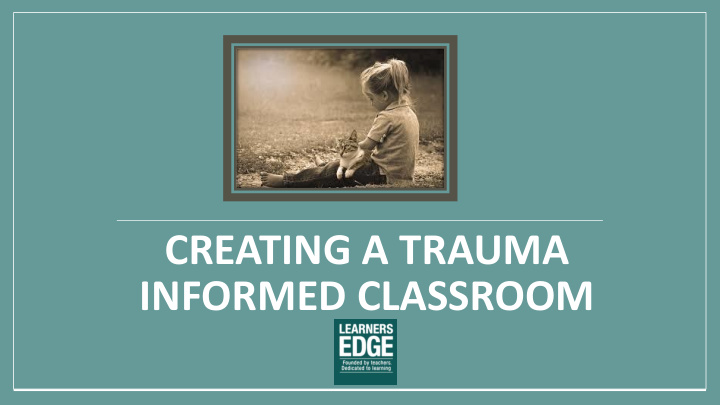



CREATING A TRAUMA INFORMED CLASSROOM
www.LearnersEdgeInc.com
Molly Kiebel, Presenter • Former Language Arts teacher • Married with two active daughters Loves travel and exploring the outdoors with family and friends • • Taught for 15 years in both Minnesota and California Current Role: Curriculum & Instruction Specialist • Susanne Leslie, Moderator • Proud mother of a recent UW Badger graduate and a U of M Golden Gopher senior Loves anything and everything outdoors – during all four Minnesota seasons • • Former parent educator Has been with Learners Edge for ten years • • Current Role : Lead Curriculum & Instruction Specialist at Learners Edge www.LearnersEdgeInc.com
“Everybody thinks you should be happy just because you're young. They don't see the wars that we fight every single day. And one day, my war will end. And I won't die. And I will not tolerate abuse from anyone. I am strong.” -Freedom Writers, 2007 www.LearnersEdgeInc.com
Goals Today • What is trauma? • How does trauma impact students? • How can we create a trauma- sensitive classroom? • How can we support ourselves as we care for students impacted by trauma? www.LearnersEdgeInc.com
What is Trauma? An exceptional experience in which powerful and dangerous events overwhelm a person’s capacity to cope (Rice and Groves, 2005) A sudden or unexpected experience that creates a lasting substantial, psychological impact (Malchiodi, 2008) www.LearnersEdgeInc.com
ACEs Study: Adverse Childhood Experiences! https://vimeo.com/139998006 www.LearnersEdgeInc.com
ACEs in School ACEs have short and long-term impact on physical and mental health • Substance abuse in the home • Parental separation or divorce • Mental illness in the home • Witnessing domestic violence • Suicidal family member • Death of a loved one • Parental incarceration • Experience of abuse • Natural disasters, criminal behavior in the home, homelessness, and bullying www.LearnersEdgeInc.com
www.LearnersEdgeInc.com
Incidence of Childhood Trauma? Approximately 50% of U.S. children, nearly 35 million, have experienced at least one type of childhood trauma 1/3 of youths ages 13-17 have experienced more than one type of trauma National Survey of Children’s Health, 2013 www.LearnersEdgeInc.com
Impact of Trauma on Teaching and Learning Trauma impacts reasoning, planning, and emotional control Survival Mode: What Trauma Can Look Like in the Classroom* FIGHT FLIGHT FREEZE Acting silly Withdrawing Refusing to answer Hyperactivity Fleeing Blank looks Defiance Seeming to sleep Appearing numb Aggression Wandering or hiding Feeling unable to move or act Yelling *from Fostering Resilient Learners: Strategies for Creating a Trauma-Sensitive Classroom , 2016 www.LearnersEdgeInc.com
How to Support Students Implement classroom-wide strategies to assist the needs of all learners Strategies: Empower students to self-regulate Create a safe learning environment Provide flexibility and choice Foster stable relationships Practice self-care www.LearnersEdgeInc.com
Encourage Self-Regulation in the Classroom! Help students understand the impact of stress and promote self-management Strategies: • Teach common language • Fidgets • Movement and breathing exercises • Quiet spaces • Creativity breaks https://www.youtube.com/watch?v=gm9CIJ74Oxw www.LearnersEdgeInc.com
Create Safe Learning Environments Move students from survival mode to learning mode through the creation of safe and predictable classrooms Strategies: • Establish clear expectations • Create a sense of belonging • Build predictable routines www.LearnersEdgeInc.com
Provide Choice and Flexibility Help students overcome lagging skills by providing choice and flexibility Strategies: • Seating: where and how • Work and Assessments: choice boards, question completion, format, partners • Rules: focus on the objectives www.LearnersEdgeInc.com
Foster Stable Relationships Encourage emotional bonds and social skills through positive interactions and community-building Strategies: • Share personal interests • Celebrate success • Model and role-play social skills • Focus on strengths www.LearnersEdgeInc.com
Teacher Self-Care Take care of yourself so you can take care of others Secondary Trauma/Compassion Fatigue: A normal reaction to abnormal circumstances Self-care: • Health • Self-compassion • Gratitude • Mindset www.LearnersEdgeInc.com
www.LearnersEdgeInc.com
Strength and Health Exercise Nutrition Calming Techniques www.LearnersEdgeInc.com
Self-Compassion and Gratitude Quiet the inner critic Focus on your mission Practice compassionate acts Express gratitude www.LearnersEdgeInc.com
Mindset Do not take student misbehavior personally Convey calm through words and action Recognize and heal personal triggers www.LearnersEdgeInc.com
QUESTIONS? www.LearnersEdgeInc.com
Sources & Resources Souers, K., & Hall, P. (2016). Fostering Resilient Learners: Strategies for Creating a Trauma-Sensitive Classroom. ASCD. Text also serves as the foundational text for our new course launching March 16, 2017 : Trauma-Sensitive Teaching: Helping Students Overcome Adverse Experiences ___________________________________________________________________________ Dan Siegel. www.drdansiegel.com, 2017. James Redford (Director). 2016. Paper Tigers [Motion picture]. United States: KPJR Films. Mark Sander. EdTalks: Mark Sander: Trauma-Informed Classrooms, 2017. https://www.achievempls.org/edtalks National Child Traumatic Stress Network. www.nctsn.org Richard LaGravanese (Director). 2007. Freedom Writers [Motion picture]. United States: Paramount. Ross Green. www.livesinthebalance.org, 2017. Teacher Resources www.Mindfulteachers.org https://www.livingwell.org.au/mindfulness-exercises-3/ www.LearnersEdgeInc.com
THANK YOU FOR JOINING US! www.LearnersEdgeInc.com
Recommend
More recommend